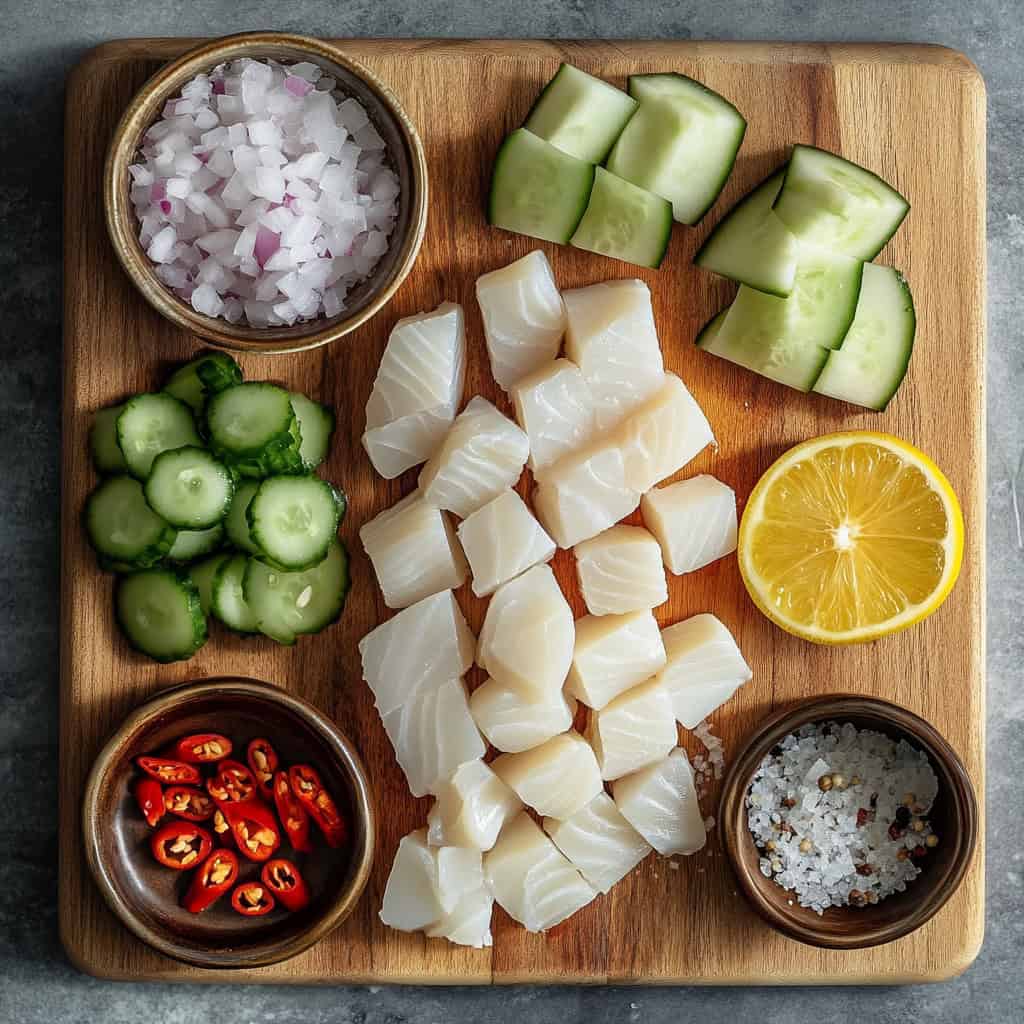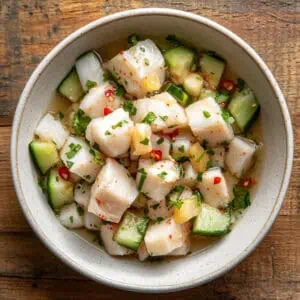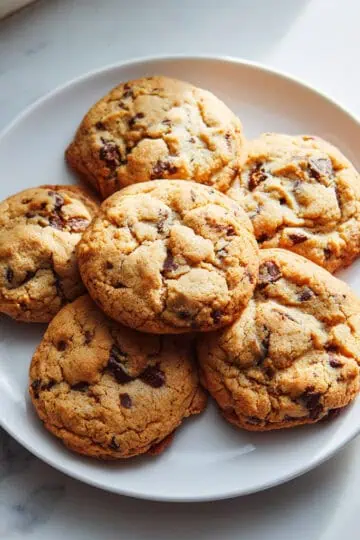I will teach how to cook my father's favorite Kinilaw Na Isda. This refreshing Filipino dish has been my go-to recipe whenever I want to impress guests without spending hours at the stove.
Think of it as the Philippines' answer to ceviche - fresh fish "cooked" in a vibrant mixture of vinegar, citrus, and aromatic ginger. I fell in love with this dish during my travels through the Visayas region and have perfected it over countless family gatherings.
The combination of tender fish, crisp cucumbers, and zesty marinade creates an explosion of flavors that will transport you straight to a beachside Filipino fiesta.
Whether you're looking for a light appetizer or a refreshing side dish that pairs perfectly with cold drinks, this Kinilaw Na Isda recipe is guaranteed to become your new favorite way to enjoy seafood.
What is Kinilaw Na Isda
Kinilaw Na Isda is a traditional Filipino dish particularly popular in the Visayas region of the Philippines. Similar to Latin American ceviche, this dish "cooks" fresh fish in acidic liquids (vinegar and citrus) rather than with heat. The acidity denatures the proteins in the fish, effectively "cooking" it while preserving its tender texture.
This refreshing appetizer is commonly served at social gatherings and pairs exceptionally well with beer and other spirits.
Jump to:
Why You'll Love This Recipe
This refreshing Filipino ceviche-style dish bursts with vibrant flavors that perfectly balance tanginess, spice, and freshness. The combination of vinegar and citrus "cooks" the fish while preserving its delicate texture.
It's incredibly easy to prepare, requires no actual cooking, and makes an impressive appetizer for gatherings. If you enjoy bold, zesty flavors and fresh seafood, this authentic Filipino dish will quickly become a favorite in your recipe collection.
Ingredients
Each ingredient in this Kinilaw Na Isda plays an essential role in creating the perfect balance of flavors and textures. The fresh fish provides a delicate canvas, while the vinegar and calamansi juice "cook" the fish and add bright acidity.
Ginger brings warmth and a subtle spicy kick that complements the seafood beautifully. The crisp cucumber adds refreshing crunch and helps mellow the tanginess, while onions contribute a sweet-sharp flavor that deepens with marination. For those who enjoy heat, the chili peppers add just the right amount of spice without overwhelming the dish.
These ingredients aren't just traditional, they create a perfect harmony of flavors that has been enjoyed in Filipino coastal communities for generations.

- 1 pound of fish filet (herring/tamban recommended), cut into bite-size pieces
- 1 medium-sized onion, finely chopped
- 1 large knob of ginger, peeled and minced
- 1 large cucumber, peeled and thinly sliced
- 1 cup of vinegar (white or cane vinegar preferred)
- 4 calamansi lemons, juiced
- 2 small chili peppers, minced
- Salt to taste
- Freshly ground black pepper
Equipment
- Large mixing bowl
- Sharp knife and cutting board
- Citrus juicer (optional)
- Measuring cups

How To Make
- Combine the vinegar and calamansi juice in a large mixing bowl.
- Stir briefly to mix these together.
- Add the minced ginger and chopped onion to the mixing bowl and stir.
- Let this mixture sit for 5 minutes to allow flavors to blend.
- Add the cucumber and fish to the mixing bowl.
- Stir and toss until the mixture is well blended with the fish and vegetables.
- Taste the liquid then adjust the flavor using more or less salt, vinegar, and citrus juice, as needed.
- If you prefer it spicy, add the minced chilis and stir again.
- Let this sit for at least 5 minutes then serve chilled or at room temperature.

Tips from Lola's Kitchen
- Use the freshest fish possible – freshness is crucial for both safety and flavor.
- Cut the fish against the grain for the most tender texture.
- For a more intense flavor, allow the fish to marinate for up to 30 minutes.
- Keep all ingredients chilled before preparation for the best texture and taste.
- The ratio of vinegar to citrus juice can be adjusted based on your preference for tanginess.
- Serve in clear glass bowls to showcase the vibrant colors of this beautiful dish.
Substitutions
- Fish Options: While herring (tamban) is traditional, you can use any fresh, firm white fish like snapper, sea bass, or mahi-mahi.
- Citrus: Lemon or lime juice works perfectly if calamansi isn't available.
- Vinegar: White vinegar or cane vinegar is traditional, but apple cider vinegar can work in a pinch.
- Heat Level: Adjust the amount of chili peppers based on your spice preference, or substitute with a dash of red pepper flakes.
- Add-ins: Some regions add tomatoes, bell peppers, or a splash of coconut cream for variation.
Troubleshooting
- Fish Turns Tough: The fish may have marinated too long. Limit marination to 30 minutes maximum.
- Too Acidic: Balance with a pinch of sugar or add more cucumber to mellow the flavors.
- Too Mild: Add more ginger, chilis, or black pepper to intensify the flavor.
- Fish Looks Raw: This dish is similar to ceviche where the acid "cooks" the fish. If the fish still appears translucent after 15 minutes, it may need to marinate longer or be cut into smaller pieces.
Storage & Reheating
- Kinilaw is best enjoyed fresh, ideally within 2 hours of preparation.
- If you must store leftovers, keep in an airtight container in the refrigerator for up to 24 hours.
- This dish should not be reheated as it is designed to be eaten cold or at room temperature.
- The acid will continue to "cook" the fish, so the texture may change if stored too long.

FAQ
Is Kinilaw safe to eat since the fish isn't cooked with heat?
Yes, when prepared properly with fresh fish and sufficient acid (vinegar and citrus), the acid denatures the proteins similar to cooking. However, always use the freshest fish possible from a reputable source.
Can I prepare Kinilaw in advance?
It's best prepared fresh, but you can prep all ingredients in advance and combine them 15-30 minutes before serving.
What should I serve with Kinilaw Na Isda?
Traditionally, it's served with room temperature rice (not hot rice) and often accompanied by cold beer or other beverages. It also pairs well with grilled dishes at a Filipino feast.
How do I select the best fish for Kinilaw?
Look for fish with clear eyes, firm flesh, and a fresh ocean smell. When in doubt, ask your fishmonger for the freshest catch of the day suitable for ceviche or raw preparations.
Can I make this dish less spicy?
Absolutely! The chili peppers are optional and can be reduced or omitted entirely based on your spice preference.
Related
Looking for other recipes like this? Try these:

Kinilaw Na Isda (Filipino Ceviche with Vinegar and Ginger)
Ingredients
- 1 pound of fish filet herring/tamban recommended, cut into bite-size pieces
- 1 medium-sized onion finely chopped
- 1 large knob of ginger peeled and minced
- 1 large cucumber peeled and thinly sliced
- 1 cup of vinegar white or cane vinegar preferred
- 4 calamansi lemons juiced
- 2 small chili peppers minced
- Salt to taste
- Freshly ground black pepper
Instructions
- Combine the vinegar and calamansi juice in a large mixing bowl.
- Stir briefly to mix these together.
- Add the minced ginger and chopped onion to the mixing bowl and stir.
- Let this mixture sit for 5 minutes to allow flavors to blend.
- Add the cucumber and fish to the mixing bowl.
- Stir and toss until the mixture is well blended with the fish and vegetables.
- Taste the liquid then adjust the flavor using more or less salt, vinegar, and citrus juice, as needed.
- If you prefer it spicy, add the minced chilis and stir again.
- Let this sit for at least 5 minutes then serve chilled or at room temperature.
Tips from Lola's Kitchen
- Use the freshest fish possible – freshness is crucial for both safety and flavor.
- Cut the fish against the grain for the most tender texture.
- For a more intense flavor, allow the fish to marinate for up to 30 minutes.
- Keep all ingredients chilled before preparation for the best texture and taste.
- The ratio of vinegar to citrus juice can be adjusted based on your preference for tanginess.
- Serve in clear glass bowls to showcase the vibrant colors of this beautiful dish.
The Story Behind Kinilaw Na Isda
Kinilaw Na Isda stands as one of the Philippines' most ancient culinary treasures, with roots stretching back to pre-colonial times. Long before Spanish influence reached Philippine shores, coastal communities throughout the archipelago were preparing fresh-caught fish with native vinegars and citrus. This traditional Filipino ceviche showcases the ingenious food preservation techniques developed by early Filipinos who needed ways to enjoy seafood without cooking fires.
The word "kinilaw" comes from "kilaw," meaning "eaten fresh" in several Filipino dialects, highlighting the dish's raw preparation method. While now beloved throughout the Philippines, kinilaw's heart remains in the Visayas region, where abundant marine life and a tradition of vinegar production created the perfect environment for this dish to flourish. In coastal towns across islands like Cebu, Bohol, and Negros, families have passed down their special kinilaw recipes for generations.
What makes authentic Filipino kinilaw unique compared to Latin American ceviche is its use of coconut or cane vinegar alongside citrus juice. This dual-acid approach creates a more complex flavor profile and "cooks" the fish more thoroughly. The addition of ginger—a signature Filipino ingredient—further distinguishes kinilaw with its warming, aromatic qualities that perfectly complement seafood.
In traditional Filipino food culture, kinilaw na isda serves an important social function. Often prepared for gatherings and celebrations, it's typically enjoyed as "pulutan"—a shared appetizer served with alcoholic beverages. The bright, tangy flavors cleanse the palate and balance the richness of other Filipino dishes, making it an essential component of a complete Filipino feast.
The beauty of kinilaw lies in its regional variations. In some coastal areas, locals add coconut milk for creaminess, while other regions incorporate tropical fruits like green mangoes or star fruit. In the Mindanao region, you might find additional spices and herbs that reflect the island's connections to Indonesian and Malaysian cuisines. Each family's version tells a story of local ingredients, personal taste preferences, and culinary heritage.
Today, as Filipino cuisine gains global recognition, kinilaw na isda is emerging as an ambassador of Filipino flavors. Modern Filipino chefs are presenting elevated versions in restaurants worldwide, while home cooks continue to prepare it as they have for centuries—with fresh ingredients and respect for tradition. This simple yet sophisticated dish embodies the Filipino approach to cooking: honoring fresh ingredients, balancing bold flavors, and bringing people together through food.
Whether you're discovering kinilaw for the first time or reconnecting with a taste of home, this dish offers more than just flavor—it provides a direct connection to centuries of Filipino culinary wisdom and the coastal communities that have treasured it for generations.










Comments
No Comments